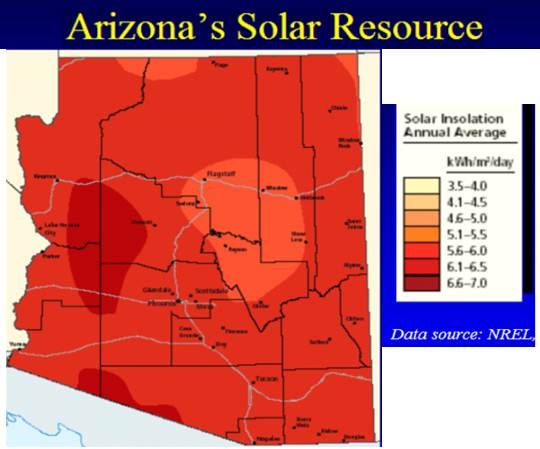With GTM heading to Phoenix for a Solar Summit May 1-2, it seemed only right to take a look at how sun is doing in Arizona.
“Arizona has the highest solar insolation in the country and we have a modest Renewable Energy Standard,” Arizona Sierra Club Director Sandy Bahr explained. “It does have a distributed carve-out, but it’s modest.” And, she added, “we’ve seen a lot happen with solar in the last five years,” ticking off growth in solar rooftops, solar power plants and community solar that has reached “even to the Sun City Recreation Centers.”
At the end of 2010, Arizona had 128 megawatts of installed solar capacity. Its Renewable Energy Standard (RES) requires Arizona Corporation Commission (ACC)-regulated utilities, which include Arizona Public Service (APS) and Tucson Electric Power (TEP), to obtain 15 percent of their power from renewable sources by 2025 and specifies that 30 percent of that come from distributed generation.
Salt River Project, Arizona’s second largest utility, is not regulated by the ACC, but has set a goal to obtain 20 percent of its power from sustainable resources, which include demand response and energy efficiency as well as renewables, by 2020.

“And yet,” Bahr said, “the Corporation Commission keeps wavering on whether or not it’s supportive of the RES and sometimes expresses outright hostility to it.”
The most notorious example of the ACC’s wavering, Bahr said, came after the five-person commission was reconstituted along more conservative lines in the November 2010 election.
In July 2011, the ACC voted, along strict party lines, three Republicans to two Democrats, to allow Mohave Electric to substitute an 11-megawatt trash-to-gas power plant for part of its RES obligation. This was granted despite the fact that when the standard was originally set, in 2007, it specifically ruled trash-to-gas as too polluting an electricity source to be a substitute for renewables.
Mohave Electric CEO Tyler Carlson argued that the trash-to-gas power plant could reduce costs to ratepayers by saving some of what the utility spends on solar. But “the trash-burner costs almost twice as much to build” and “twenty times more to run,” Democratic Commissioner Paul Newman told GTM, questioning the Republican commissioners’ approval of the project. “What are they thinking, and whose interests are they serving?"
The commission’s decision is currently under legal scrutiny and reconsideration may be required; whether the political atmosphere will support a reversal remains to be seen.
Another political shift, the Sierra Club’s Bahr said, is happening in the state legislature. “It is considering a bill that would cap the RES. Why you would cap it is beyond me.” Developers, installers and manufacturers have been attracted to the state because of strong policies, she explained.
“When Suntech decided to come to Arizona with a manufacturing facility,” she recalled, “the Renewable Energy Standard was one of the key reasons because it provides certainty and stability.”
Now, Bahr said, solar industry people point to policy inconsistency as an obstacle to solar growth. “Messing around with that, which is what I see the Corporation Commission and the legislature trying to do, weakening it, just makes no sense. Here you have the one of the few industries that has been growing in Arizona during this difficult economic period and providing jobs and helping people lower their electric bills.”
Phoenix construction jobs dropped 14.4 percent in 2010, according to the Arizona Department of Commerce, but Arizona moved from eighth to third place nationally in providing solar employment, going from approximately 3,800 to 4,786 jobs, in 2011. A third of those jobs were in installation.

Arizona also has, according to a National Renewable Energy Lab study, the third best combination of land area and resource potential in the U.S. for utility-scale solar power plant development (behind Utah and New Mexico). In 2011, Arizona had nine utility-scale projects with power purchase agreements (PPAs), eight of them photovoltaic projects.
Bahr said her Sierra Club chapter supported Abengoa’s 250-megawatt concentrating solar project. “It is located on former agricultural land,” she said. “We thought it was important to support a good, well-located project.”
Concerns with other proposals, like NextEra Energy’s 300-megawatt Sonoran Solar Energy Project, Bahr said, were addressed satisfactorily in the National Environmental Policy Act (NEPA) permitting process. “It was originally solar thermal. The conservation community had a lot of concerns about water use because it was located on virgin desert and it was going to be using ground water.”
During the NEPA permitting process, she said, “they came up with a photovoltaic alternative. It reduced the footprint and was moved away from some major washes so the project is no longer controversial.” But, she added, “they don’t have a PPA.” Asked why, she could only answer, “Good question. We don’t know.”
The failure of politicians and utility executives to back solar, Bahr said, defies more than logic. “I’ve seen a lot of polling on solar, including polling that was done by the utilities themselves,” she noted. “People consistently had very strong support for solar energy resources even when asked if they would pay more.”
She has seen, Bahr said, “very few things that have the kind of support with the public that solar energy does. It’s just unfortunate that some of our elected officials don’t get that. The public is there. We just need to bring along the officials -- or find new ones.”



